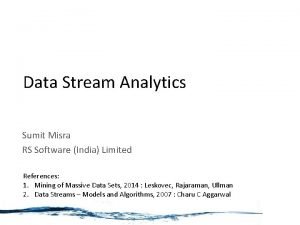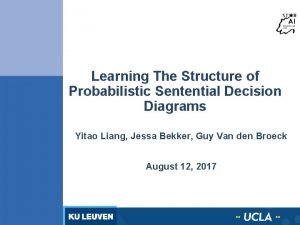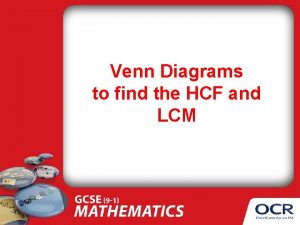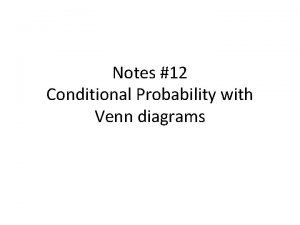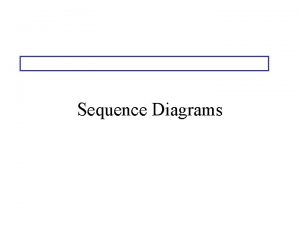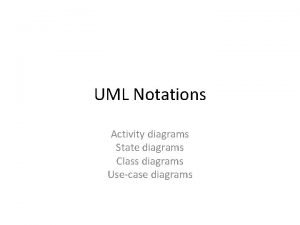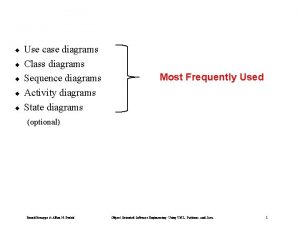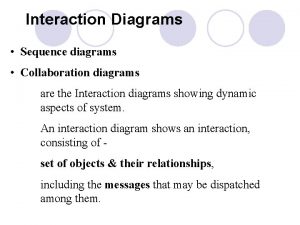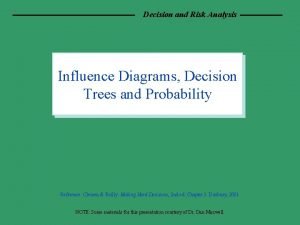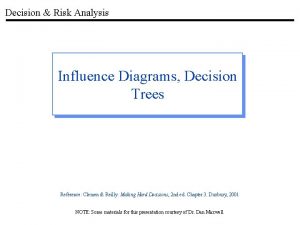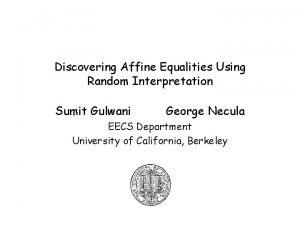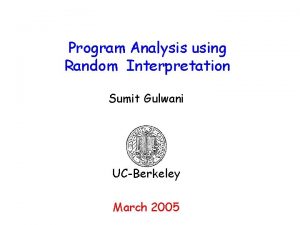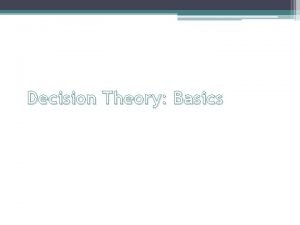Stochastic Planning using Decision Diagrams Sumit Sanghai Stochastic


















![Approximate ADDs • At each leaf node ? – Range : [min, max] – Approximate ADDs • At each leaf node ? – Range : [min, max] –](https://slidetodoc.com/presentation_image_h2/1581756703edd299fed9c8ceb6b9f71a/image-19.jpg)


- Slides: 21

Stochastic Planning using Decision Diagrams Sumit Sanghai

Stochastic Planning • MDP model ? – Finite set of states S – Set of actions A, each having a transition probability matrix – Fully observable – A reward function R associated with each state

Stochastic Planning … • Goal ? – Policy which maximizes the expected total discounted reward in an infinite horizon model – Policy is a mapping from state to action • Problem ? – Total reward can be infinite • Solution ? – Associate a discount factor b

Expected Reward Model • Expected Reward Model – Vp(s) = R(s) + b åt Pr(s, p(s), t) Vp(t) • Optimality ? – Policy p is optimal if Vp >= Vp` for all s and p` • Thm : There exists an optimal policy – Its value function is denoted as V*

Value Iteration • Vn+1(s) = R(s) + maxa b åt Pr(s, a, t) Vn(t) V 0(s) = R(s) • Stopping condition : – if maxs {Vn+1(s) – Vn(s)} < e(1 -b) / 2 b then Vn+1 is e/2 close to V* • Thm : Value Iteration gives optimal policy • Problem ? – Can be slow if state space too large

Boolean Decision Diagrams • Graph Representation of Boolean Functions • BDD = Decision Tree – redundancies – Remove duplicate nodes – Remove any node with both child pointers pointing to the same child

BDDs… x 1 x 2 x 3 0 0 1 1 0 1 0 1 f 1 0 0 1 1 0 x 1 x 2 x 3 0 x 2 x 3 1 x 2 x 3 0 1 x 3 0 x 2 x 3 1 x 3 0 1

BDDs operations 1 1 or 2 0 1 1 = 2 0 1 2 1 1 0

Variable ordering (a 1 ^ b 1) v (a 2 ^ b 2) v (a 3 ^ b 3) Linear Growth Exponential Growth

BDD no magic • Number of boolean functions – 2^{2^n} • With polynomial nodes – Exponential functions

ADDs • BDDs + real valued domain • Useful to represent probabilities

MDP, State Space and ADDs • Factored MDP – S characterized by {X 1, X 2, …, Xn} • Action a from s to s` a from {X 1, X 2, …, Xn} to {X 1`, X 2`, …, Xn`} • Pr(s, a, s`) ? – Pra(Xi`|X 1, X 2, …, Xn) – Each can be represented using ADD

Value Iteration Using ADDs • Vn+1(s) = R(s) + b maxa {åt P(s, a, t) Vn(t)} – R(s) : ADD • P(s, a, t)=Pa(X 1`=x 1`, …, Xn`=xn`|X 1=x 1, …, Xn=xn) = Õi. P(Xi`=xi`|X 1=x 1, …, Xn=xn) Vn+1(X 1, …, Xn) = R(X 1, …Xn) + b maxa {åX 1`, …, Xn` Õi Pa(Xi`|X 1, …, Xn) Vn(X 1`, …, Xn`)} • 2 nd term on RHS can be obtained by quantifying X 1` first as true or false and multiplying its associated ADD with Vn and summing over all possibilities to eliminate X 1` åX 1`, …, Xn` {Õi=2 to n {Pa(Xi`|X 1, …, Xn)} (Pa(X 1`=true|X 1, …, Xn) Vn(X 1`=true, …, Xn`) + Pa(X 1`=false|X 1, …, X_n) Vn(X 1`=false, …, Xn`) )}

Value Iteration Using ADDs (other possibilities) • Which variables are necessary ? – variables appearing in the value function • Order of variables during elimination ? – Inverse order • Problem ? – Repeated computation of Pr(s, a, t) • Solution ? – Precompute Pa(X 1`, …, Xn`|X 1, …, Xn) – Mutliply the dual action diagrams

Value Iteration… • Space vs Time ? – Precomputation : huge space required – No precomputation : time wasted • Solution (do something intermediate) – Divide variables into sets (restriction ? ? ) and precompute for them • Problems with precomputation – Precomputation for sets containing variables which do not appear in value function – Dynamic precomputation

Experiments • Goals ? • SPUDD vs Normal value iteration – What is SPI ? – How is comparison done ? • Worst case of SPUDD • Missing links ? – SPUDD vs Others – Space vs Time experiments

Future Work • • Variable reordering Policy iteration Approximate ADDs Formal model for structure exploitation – BDDs eg. Symmetry detection • First order ADDs

Approximate ADDs x 1 x 2 x 3 0. 9 x 2 x 3 1. 1 0. 1 x 2 x 3 6. 7 x 2 x 3 [0. 9, 1. 1] 0. 1 x 3 6. 7
![Approximate ADDs At each leaf node Range min max Approximate ADDs • At each leaf node ? – Range : [min, max] –](https://slidetodoc.com/presentation_image_h2/1581756703edd299fed9c8ceb6b9f71a/image-19.jpg)
Approximate ADDs • At each leaf node ? – Range : [min, max] – What value and error do you associate with that leaf ? • How and till when to merge the leaves ? – max_size vs max_error • Max_size mode – Merge closest pairs of leaves till size < max_size • Max_error mode – Merge pairs such that error < max_error

Approximate Value Iteration • Vn+1 from Vn ? – At each leaf node do calculation for both min and max : eg [min 1, max 1]*[min 2, max 2] = [min 1*min 2, max 1*max 2] – What about maxa step ? – Reduce again • When to stop ? – When the ranges for every state in 2 consecutive value functions overlap or lie within some tolerance (e) • How to get policy ? – Find actions which maximize value functions (when range is replaced by midpoints) • Convergence ?

Variable reordering • Intuitive ordering – Variables which are correlated should be placed together • Random – Pick pairs of variables and swap them • Rudell’s sifting – Pick a variable, find a better position • Experiments : Sifting did very well
 No decision snap decision responsible decision
No decision snap decision responsible decision Dividend decision in financial management
Dividend decision in financial management Sumit saluja
Sumit saluja Sumit misra
Sumit misra Sumit dinda
Sumit dinda Sumit lodhia
Sumit lodhia Sumit sharma teri
Sumit sharma teri The interaction diagrams, use case diagrams are called as
The interaction diagrams, use case diagrams are called as Uml activity diagram tutorial
Uml activity diagram tutorial Sentential decision diagrams
Sentential decision diagrams Hcf by venn diagram
Hcf by venn diagram Formula for probability of a given b
Formula for probability of a given b Using tape diagrams to solve ratio problems
Using tape diagrams to solve ratio problems Decision tree and decision table examples
Decision tree and decision table examples Using recursion in models and decision making
Using recursion in models and decision making Using recursion in models and decision making sheet 3
Using recursion in models and decision making sheet 3 Decision tree in supply chain management
Decision tree in supply chain management Decision making using excel
Decision making using excel Basic elements of planning and decision making
Basic elements of planning and decision making Management chapter 5 planning and decision making
Management chapter 5 planning and decision making Individual and group decision making
Individual and group decision making Options-based planning
Options-based planning



